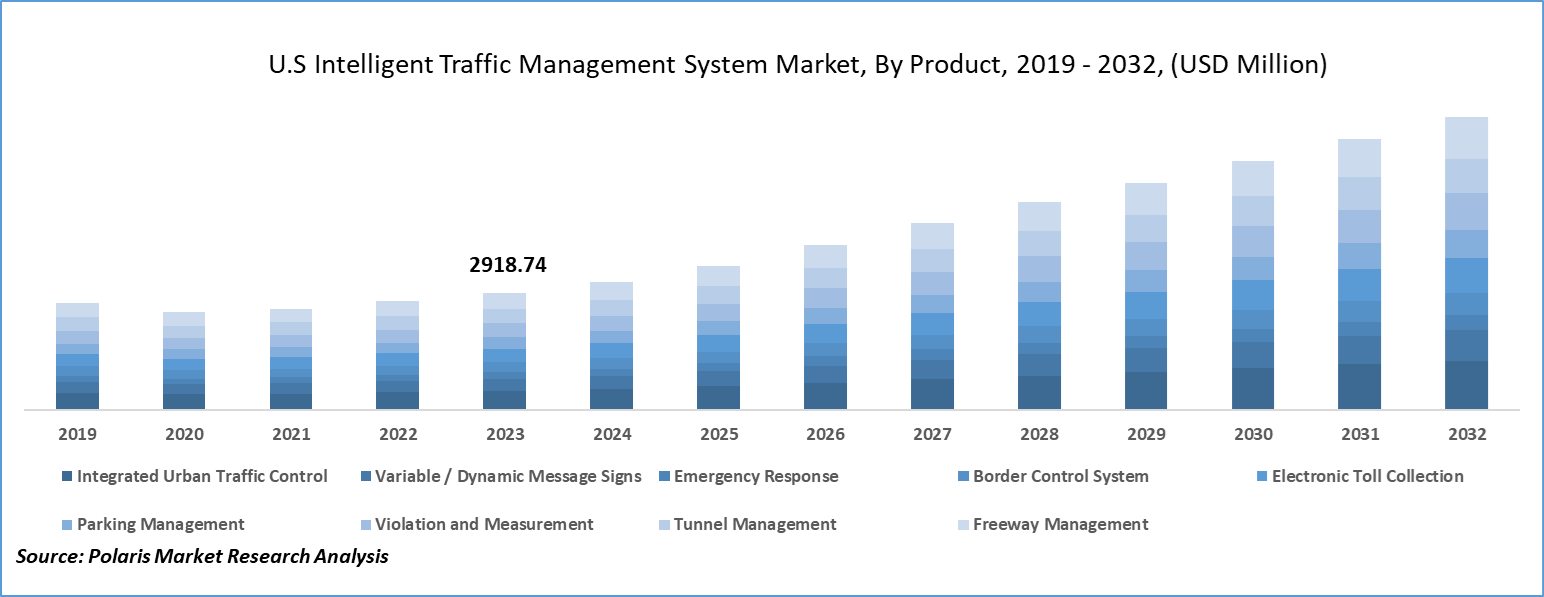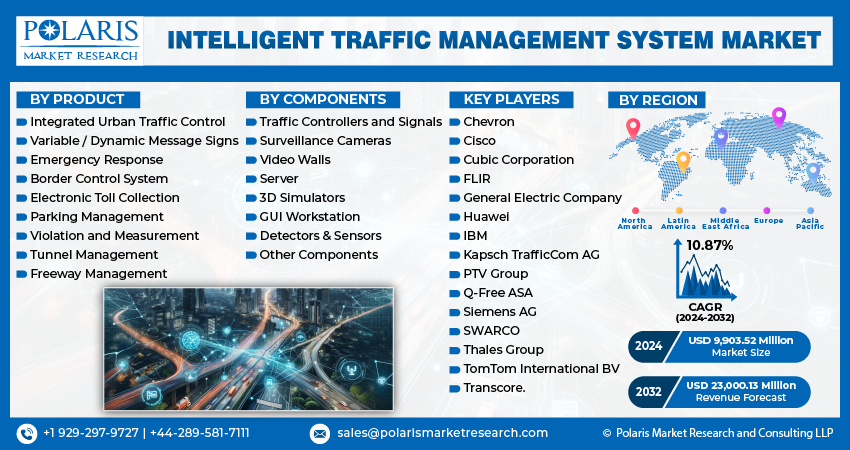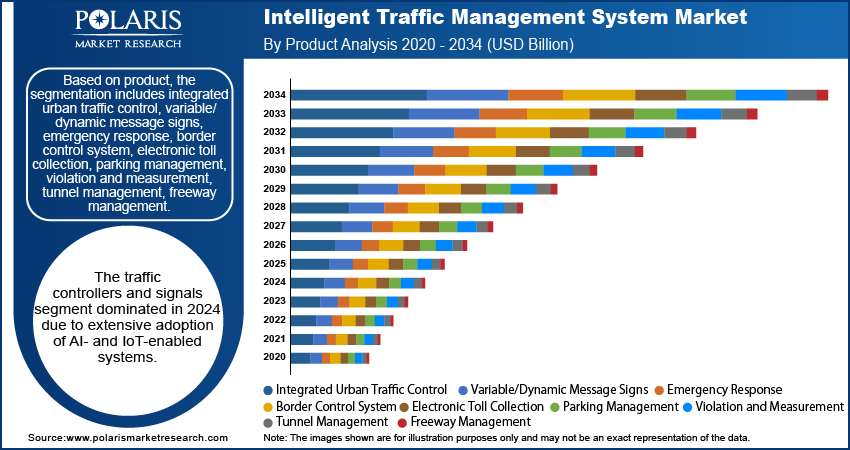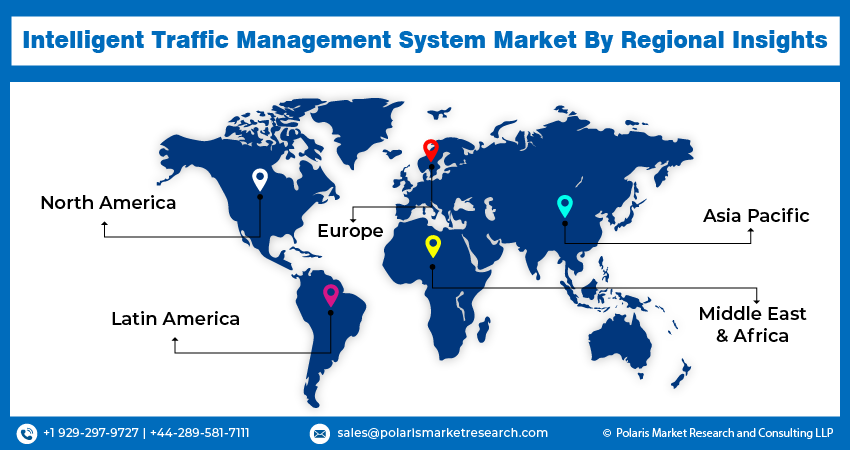
Intelligent Traffic Management System Market Share, Size, Trends, Industry Analysis Report
By Product; By Components (Traffic Controllers and Signals, Surveillance Cameras, Video Walls, Server, 3D Simulators, GUI Workstation, Detectors & Sensors, Other Components); By Region; Segment Forecast, 2024 - 2032
- Published Date:Jun-2023
- Pages: 117
- Format: PDF
- Report ID: PM2340
- Base Year: 2023
- Historical Data: 2019-2022
Report Outlook
Global Intelligent Traffic Management System Market Size was valued at USD 9,084.97 Million in 2023. The Intelligent Traffic Management System Industry is projected to grow from USD 9,903.52 Million in 2024 to USD 23,000.13 Million by 2032, exhibiting a compound annual growth rate (CAGR) of 10.87% during the forecast period (2024 - 2032). The rapid advancements in Information and Communication Technology (ICT) and the emergence of Industry 4.0, machine automation, embedded systems, and data analytics integration in Intelligent Traffic Management Systems (ITMS) drive the demand for intelligent traffic management systems worldwide. These technological advancements allow manufacturers to expand their product offerings and provide customers with a wide range of goods and services. Furthermore, the increasing need to enhance safety and address environmental and congestion issues globally is expected further to fuel the development of intelligent transportation management systems.

To Understand More About this Research: Request a Free Sample Report
Intelligent transportation control improves safety, addresses emissions concerns, and reduces traffic congestion. By leveraging various information and communication technologies in all passenger and freight transportation modes, transportation systems can be enhanced to be safer, more environmentally friendly, and more efficient. This integration of technologies enables the optimization of transportation operations, leading to improved overall transportation experiences for individuals and businesses alike.
Furthermore, the increasing adoption of connected and autonomous vehicles (CAVs) is expected to drive the demand for intelligent traffic management systems. These systems can communicate with CAVs to optimize traffic flow, reduce accidents, and enhance efficiency. As the deployment of CAVs expands, the need for advanced traffic management systems to handle complex interactions between vehicles and infrastructure will become even more critical.
The intelligent traffic management system market also benefits from advancements in communication technologies, such as 5G networks. Faster and more reliable communication networks enable real-time data exchange between vehicles, infrastructure, and control centers, facilitating more efficient traffic management.
The COVID-19 pandemic significantly impacted the intelligent traffic management system market, causing disruptions in implementation, a temporary reduction in traffic volumes, and a shift towards emphasizing safety and efficiency. Many projects were delayed or halted due to restrictions and budget constraints, while the decreased demand for traffic management solutions resulted from reduced vehicle presence on the roads during lockdowns. However, the pandemic highlighted the value of intelligent traffic management systems in optimizing traffic flow and supporting health measures, such as dynamic lane management for COVID-19 testing and vaccination sites. Despite the short-term setbacks, the market's long-term outlook remains positive, driven by the growing need for efficient transportation solutions, smart city initiatives, and technological advancements like artificial intelligence and data analytics. As economies recover and cities develop, the demand for intelligent traffic management systems is expected to rise, enhancing traffic management and optimization in the post-pandemic era.
Industry Dynamics
Growth Drivers
The market is fueled by rapid urbanization plays a significant role as cities expand and populations increase, creating a pressing need for effective traffic management. Intelligent traffic management systems offer solutions to mitigate traffic congestion, optimize traffic flow, and enhance overall transportation efficiency in urban areas. This trend is driven by ongoing urban development and the need to address the challenges of growing urban populations.
The rising traffic congestion remains a persistent issue in many urban regions, resulting in longer travel times, increased fuel consumption, and environmental pollution. Intelligent traffic management systems present viable solutions to these challenges by leveraging real-time data, advanced algorithms, and predictive analytics. These systems effectively alleviate congestion by optimizing traffic signal timings, providing route guidance, and implementing effective traffic flow management, benefiting both commuters and the environment.
Furthermore, government initiatives and smart city development play a crucial role in driving the growth of the intelligent traffic management system market. Governments and transportation authorities across the globe are actively investing in intelligent transportation systems as part of their smart city strategies. These initiatives aim to improve the quality of life for residents by enhancing traffic management, reducing carbon emissions, and promoting sustainable transportation options. Consequently, intelligent traffic management systems receive substantial support through government policies, regulations, and funding, further propelling their adoption and growth.
Additionally, technological advancements significantly contribute to expanding the intelligent traffic management system market. Innovations in artificial intelligence, machine learning, big data analytics, and the Internet of Things have revolutionized the capabilities of these systems. Real-time data collection, analysis, and interpretation enable more accurate and efficient traffic management decisions and interventions. As technology advances, the potential for further enhancements in traffic management systems grows, attracting increased interest and investment from various stakeholders.

Report Segmentation
The market is primarily segmented based on product, components, and region.
|
By Product |
By Components |
By Region |
|
|
|
To Understand the Scope of this Report: Speak to Analyst
Integrated Urban Traffic Control Segment Expected to Grow Fastest During Forecast Period
The integrated urban traffic control system segment is expected to exhibit the fastest growth rate during the forecast period. This is primarily attributed to utilizing a single data communication standard and protocols within the urban traffic control system, enabling efficient data sharing among various management and control applications. The demand for integrated urban traffic control systems is projected to rise as more computer applications are interconnected to enhance the efficiency of urban transportation.
The growing requirement to manage road space effectively to accommodate pedestrians, cyclists, and the elderly has become increasingly important. This necessitates comprehensive road management strategies, including lane assessments, parking controls, turning bans, one-way street structures, and tidal flow schemes. Consequently, the demand for integrated urban traffic control systems is expected to increase as authorities seek solutions to effectively manage the available road space and cater to the diverse needs of road users.
Detectors and Sensors Segment Expected to Hold Significant Revenue Shares of the Market
The detectors and sensors segment anticipated to hold significant revenue share of the market. The increasing demand for detectors and sensors is driven by advancements in Information and Communication Technologies (ICT), particularly in hardware, software, and communications. These sensors play a crucial role in collecting traffic information for signal control, with the collected data being transmitted to the Vehicle Information and Communication System Center (VICS Center).
Furthermore, government agencies are installing roadside infrastructures, including cameras and sensors, to gather data on environmental and transportation conditions. By leveraging vehicles' and devices' sensing and communication capabilities, these data can be seamlessly integrated to develop smart and intelligent transportation systems.
The market for security cameras is expected to grow at the highest CAGR during the forecast period. This growth is fueled by the need to provide real-time data, optimize vehicle traffic flow, monitor junctions, and enhance pedestrian safety. Integrating communication and information technologies enable intelligent transportation management and enhances the overall commuter experience in urban planning.

Asia Pacific is Anticipated to Hold Highest CAGR Rate During Forecast Period
The Asia Pacific region is expected to experience the highest CAGR in the market. This growth can be attributed to various factors, including the increasing car ownership leading to parking issues and the growing demand for efficient transportation solutions worldwide. These factors drive the expansion of the intelligent transportation business in the region.
The market for intelligent transportation will be further propelled by rapid advancements in fields such as data transmission, mobility, cloud computing, and sensors, all of which are integral components of the Internet of Things (IoT) architecture. However, solutions need more uniformity and standardization to avoid compatibility challenges and hinder the market's growth potential.
Additionally, Europe is expected to exhibit a significant CAGR during the forecast period. The digitization of transportation, in general, and intelligent traffic management systems (ITMS), in particular, will contribute to regional market growth. The European Commission aims to leverage ITMS as part of its digital single market agenda to enhance the management of transportation networks for both passengers and businesses. ITMS is anticipated to improve operations and travel experiences across various specialized and combined modes of transportation.

Competitive Insight
Some of the major players operating in the global market include Chevron, Cisco, Cubic Corporation, FLIR, General Electric Company, Huawei, IBM, Kapsch TrafficCom AG, PTV Group, Q-Free ASA, Siemens AG, SWARCO, Thales Group, TomTom International BV, and Transcore.
Recent Developments
- In October 2021, Yunex Traffic, a Siemens subsidiary, has expanded its partnership with HERE Technologies to offer proactive traffic control options to governments and public transportation organizations. This collaboration aims to provide advanced solutions for optimizing traffic flow, reducing congestion, and enhancing overall transportation efficiency.
Intelligent Traffic Management System Market Report Scope
|
Report Attributes |
Details |
|
Market size value in 2024 |
USD 9,903.52 million |
|
Revenue forecast in 2032 |
USD 23,000.13 million |
|
CAGR |
10.87% from 2024 to 2032 |
|
Base year |
2023 |
|
Historical data |
2019 – 2022 |
|
Forecast period |
2024 – 2032 |
|
Quantitative units |
Revenue in USD million and CAGR from 2024 to 2032 |
|
Segments Covered |
By product, By Components, By Region |
|
Regional scope |
North America, Europe, Asia Pacific, Latin America, Middle East & Africa |
|
Key Companies |
Chevron, Cisco, Cubic Corporation, FLIR, General Electric Company, Huawei, IBM, Kapsch TrafficCom AG, PTV Group, Q-Free ASA, Siemens AG, SWARCO, Thales Group, TomTom International BV, and Transcore. |
Gain profound insights into the 2023 Intelligent Traffic Management System Market with meticulously compiled statistics on market share, size, and revenue growth rate by Polaris Market Research Industry Reports. This thorough analysis not only provides a glimpse into historical trends but also unfolds a roadmap with a market forecast extending to 2032. Immerse yourself in the comprehensive nature of this industry analysis through a complimentary PDF download of the sample report.
Browse Our Top Selling Reports
Dental Insurance Market Size, Share 2024 Research Report
Mycoplasma Testing Market Size, Share 2024 Research Report
Advanced Therapy Medicinal Products CDMO Market Size, Share 2024 Research Report
Cell Therapy Market Size, Share 2024 Research Report
Animal Pregnancy Kit Market Size, Share 2024 Research Report
FAQ's
The global intelligent traffic management system market size is expected to reach USD 23,000.13 million by 2032.
Key players in the intelligent traffic management system market are Chevron, Cisco, Cubic Corporation, FLIR, General Electric Company, Huawei, IBM, Kapsch TrafficCom AG, PTV Group.
Asia Pacific contribute notably towards the global intelligent traffic management system market.
The global intelligent traffic management system market is expected to grow at a CAGR of 10.87% during the forecast period.
The intelligent traffic management system market report covering key segments are product, components, and region.
